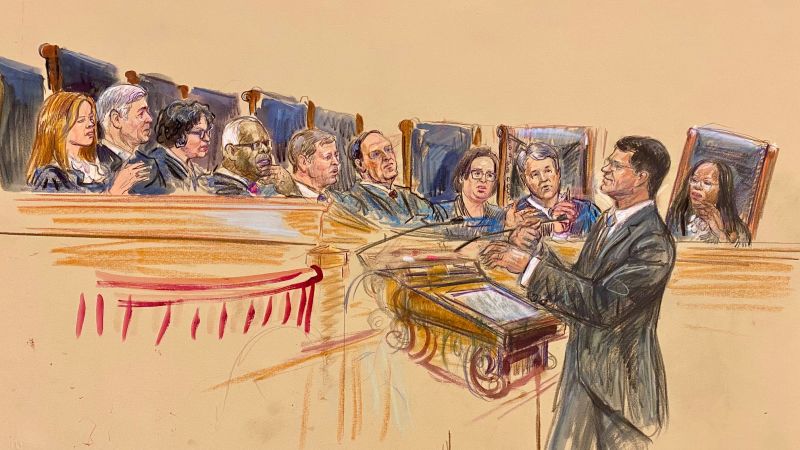On a significant Thursday, the Trump administration approached the Supreme Court with a request they characterized as “modest,” as they sought to eliminate the constitutional entitlement of birthright citizenship. This request came amid a broader conversation concerning immigration policies and executive authority that the administration had championed during Trump’s presidency.
During over two-and-a-half hours of arguments, the implications of President Donald Trump’s strategy emerged as anything but trivial. Justice Sonia Sotomayor, known for her liberal stance, expressed deep concerns regarding the fate of “thousands of children” who would potentially be born without citizenship papers, a circumstance that could render them stateless. Such comments underscored the gravity of the situation and the broader consequences that could affect generations of children in the United States.
Some justices, spanning both liberal and conservative lines, exhibited reluctance regarding the Trump administration’s appeal to lift existing court orders that barred enforcement of the executive order throughout the nation. While they seemed hesitant to immediately confront the merits of altering the 14th Amendment’s guarantee of birthright citizenship, the justices grappled with the legal and moral ramifications of such a transformative decision.
Justice Sotomayor pointed out the dubious nature of President Trump’s actions, stating, “The president is violating an established – not just one but, by my count, four established Supreme Court precedents.” This assertion highlighted the judiciary’s long-standing interpretations of the Constitution, particularly concerning citizenship rights.
Conversely, Justice Amy Coney Barrett articulated that the government frequently challenges both procedural moves and underlying constitutional issues in similar cases. She questioned whether the case’s merits were as clear-cut as the administration posited. This inquiry resonated amid uncertainties regarding the administration’s approach to the issue and signaled a division of thought among the justices.
Solicitor General D. John Sauer acknowledged that the executive order, which Trump signed on January 20, introduced a “novel” legal precedent. The order would effectively prevent children born to parents residing in the country unlawfully or under temporary visas from acquiring U.S. citizenship, raising alarms about potential statelessness among these children.
The Trump administration’s legal team contended that district court judges should not have the power to enforce broad injunctions against their policies during ongoing litigation. Sauer explained that the case warranted a more measured approach, allowing lower courts to determine the constitutional implications before the Supreme Court intervened.
However, many justices expressed frustration with the administration’s dual arguments, particularly given the significant consequences of their proposals. Any alteration that might diminish the capacity of lower court judges to check executive power would essentially provide President Trump with a greater platform to implement his policies, many of which had been blocked in lower courts.
The push against birthright citizenship aligns closely with the administration’s broader anti-immigration agenda, signifying a strategy aimed at securing national borders more effectively. In appealing a series of prior court rulings that thwarted Trump’s plan, the lawyers sought to limit the scope of injunctions to specific individuals or groups, thereby permitting wider enforcement of new citizenship regulations.
Justice Elena Kagan raised essential questions concerning the ramifications should the court permit such measures to proceed, noting the risk of an unconstitutional policy being enforced in several jurisdictions. Kagan’s probing inquiries pointed to the need for a unified citizenship rule, one aligned with historical precedents that have governed American citizenship for over a century.
As the debate progressed, Justice Neil Gorsuch highlighted the urgency of resolving foundational constitutional questions while simultaneously contemplating the adverse effects of nationwide injunctions that halt presidential policies. He and others were interested in determining how to hasten the resolution of this critical case.
Meanwhile, Chief Justice John Roberts conveyed a sense of assurance regarding the Supreme Court’s ability to expedite its ruling, emphasizing the judicial system’s capability to address pressing legal matters swiftly. He affirmed that the court could indeed bind lower court rulings regarding the president’s executive order.
The discussion culminated in an acknowledgment of the conservative majority in the Supreme Court, which has shown a tendency to support expansive executive power. Justice Brett Kavanaugh noted that presidents often operate under increasing pressures to extend their authority—especially in light of legislative hurdles within Congress. His comments underscored the ongoing tension between executive intentions and judicial scrutiny.
As discussions continued, the potential changes to birthright citizenship, rooted in the 14th Amendment, surfaced as a focal point, raising questions about the future of immigration policy in the United States and the preservation of long-standing rights. The implications for American citizenship would echo far beyond the courtroom and could redefine the landscape of immigration and citizenship in the nation going forward.



